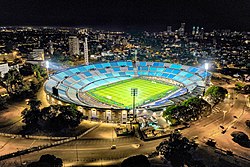
Back ملعب سنتيناريو Arabic Сентенарио (стадион) Bashkir Éstadio Cénténario BAN Естадио Сентенарио Bulgarian Estadio Centenario Breton Estadi Centenario Catalan Estadio Centenario Danish Estadio Centenario (Montevideo) German Εστάδιο Σεντενάριο Greek Estadio Centenario Spanish
 Aerial view of the stadium in 2021 | |
 | |
| Full name | Estadio Centenario |
|---|---|
| Location | Avenida Dr. Américo Ricaldoni y Federico Videla, Parque Batlle, Montevideo, Uruguay |
| Owner | Montevideo Department |
| Operator | Comisión Administradora del Field Oficial (CAFO) |
| Capacity | 60,235[1] |
| Record attendance | 79,867 Uruguay–Yugoslavia[2] (27 July 1930) |
| Field size | 105 x 68 m |
| Surface | Grass |
| Construction | |
| Broke ground | 21 July 1929 |
| Built | 1929–30 (8 months) |
| Opened | 18 July 1930 |
| Renovated | 2021 |
| Construction cost | $1,000,000 |
| Architect | Juan Antonio Scasso |
| Tenants | |
| Uruguay national football team (1930–present) Peñarol (1933–2016) | |
Estadio Centenario (English: Montevideo Centenary Stadium) is a stadium in the Parque Batlle of Montevideo, Uruguay, used primarily for staging football matches. It is owned by the Montevideo Department. The stadium was built between 1929 and 1930 to host the inaugural 1930 FIFA World Cup, as well as to commemorate the centenary of Uruguay's first constitution. It is listed by FIFA as one of the football world's classic stadiums.[3][4] On 18 July 1983, it was declared by FIFA as the first Historical Monument of World Football, to this day the only building to achieve this recognition worldwide.[5][6]
Estadio Centenario is the national stadium of Uruguay and the primary home of their national football team. Uruguay has always been a threat when playing in their home stadium, consistently beating top teams. Even the top-ranked Brazil national football team has only managed three wins in 20 attempts; two were official matches during 2010 and 2018 World Cup qualification, but one was Uruguay's heaviest defeat at the stadium when they lost 4–0 to Brazil in 2009.
- ^ INSTALACIONES
- ^ 1930 FIFA World Cup Uruguay – Matches – Uruguay-Yugoslavia – FIFA.com
- ^ FIFA.com
- ^ Gigapan Estadio Centenario. Archived 25 November 2010 at the Wayback Machine
- ^ The mythical Centenario stadium, a "Historical Monument of Football", welcomes the finals of the U-20 Sudamericano Tournament Archived 2017-08-19 at the Wayback Machine, 25 January 2015
- ^ HISTORIA Archived 2017-07-24 at the Wayback Machine (in Spanish)